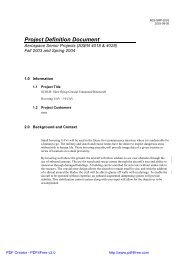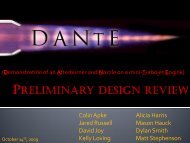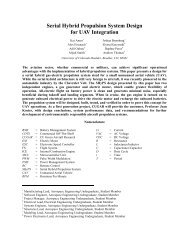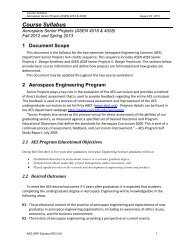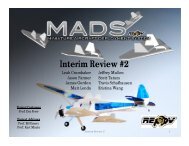PFR - Aerospace Engineering Sciences Senior Design Projects ...
PFR - Aerospace Engineering Sciences Senior Design Projects ...
PFR - Aerospace Engineering Sciences Senior Design Projects ...
Create successful ePaper yourself
Turn your PDF publications into a flip-book with our unique Google optimized e-Paper software.
Project Final Report – CUDBF April 30 th , 2009<br />
ASEN 4028: <strong>Aerospace</strong> <strong>Senior</strong> <strong>Projects</strong><br />
In order to guarantee that the designed control surfaces could produce the deflections necessary<br />
to trim the aircraft, analysis was done in AVL. Three cases were setup to determine if the<br />
necessary deflections were feasible. Under the worst case scenario (2 rockets on one wing during<br />
takeoff), the maximum deflection necessary from the rudder was 10 degrees, 15 degrees from the<br />
aileron and 15 degrees from the elevator. The maximum possible deflection is approximately 25<br />
degrees. Flow separation occurs over the wing around 25 degrees of deflection. It is clear that<br />
there is enough margin for deflection for all the control surfaces before flow separation occurs.<br />
8.1.5 Stability Analysis<br />
Stability analysis was done in AVL and in MATLAB, the code can be found in Appendix G.<br />
Non-dimensional stability derivatives were obtained from AVL for three different scenarios that<br />
mirror flight missions. The first scenario simulated a case where the centerline fuel tank is flown<br />
on the airplane for cruise conditions, the second scenario was four rockets on the airplane in<br />
cruise, and the third was the worst case scenario of two rockets on one wing tip. To get a clear<br />
understanding of the aircraft’s stability it is important to analyze stability in the longitudinal and<br />
lateral domains. The longitudinal domain refers to the stability of the aircraft about the axis of<br />
pitch. Lateral stability refers to the stability of the aircraft about the yaw and roll axis.<br />
Stability modes in the longitudinal domain are the phugoid and short period and stability modes<br />
in the lateral domain are roll subsidence, dutch roll and spiral divergence. Stability derivatives<br />
represent an incremental change in a force or moment acting on the aircraft to a corresponding<br />
change in any of the following variables: velocity, angle of attack, side slip angle, bank angle,<br />
pitch angle, pitch rate, roll rate and yaw rate. Because aircraft dynamics is fairly complex, it is<br />
necessary that the equations of motions are linearized to assess stability.<br />
The non dimensional stability derivatives outputted from AVL were dimensionalized in<br />
MATLAB to analyze dimensional stability for different modes in the longitudinal and lateral<br />
directions. Matrix methods were used to solve the set of differential equations to obtain the<br />
stability of the aircraft. The aircraft is modeled as a dynamic system where the system receives<br />
input in the form of control surface deflections implemented by the pilot. Equation 15 shows the<br />
longitudinal equations of motion. The plant that describes this system is represented by Equation<br />
16.<br />
0 − cos <br />
<br />
= + − sin <br />
<br />
0<br />
0 0 1 0<br />
0 0 0<br />
0 − <br />
= <br />
0 0<br />
<br />
0 − 1 0<br />
0 0 0 1<br />
Equation 15: Equations of Motion in Matrix Form for Longitudinal Stability<br />
<br />
= <br />
<br />
Equation 16: Representation of the Dynamic System for Longitudinal Stability<br />
64




